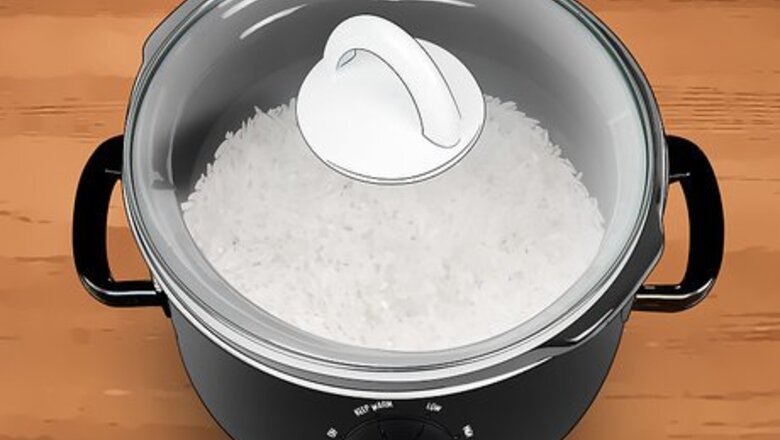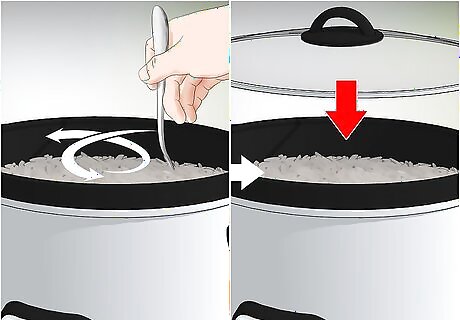
views
Using the “Keep Warm” Feature on a Rice Cooker

Cook your rice as you normally would in your rice cooker. Rice cookers are the most common tool to keep your rice warm, since you most likely used one to cook your rice in the first place. Each rice cooker cooks rice differently, so just follow the cooking instructions that it came with.

Keep your rice cooker on and switch it to its “keep warm” function. Once your rice is cooked, just switch the function from “cook” to “keep warm.” It should be able to keep your rice warm for 2 to 3 hours. Rice left warming in a rice cooker past the 2 to 3 hours will begin to become gummy or even stick to the rice cooker and burn. It will still be edible, but the quality may drastically decrease. Just do not leave it warming longer than a day in the rice cooker as it can start to grow bacteria. Not all rice cookers will have a warming function. So make sure that yo ahead of time.

Add 1 tablespoon (15 mL) of water per cup of cooked rice. The rice cooker will slowly remove moisture from the cooked rice. So adding water will help prevent your cooked rice from drying out, and add moisture back into the cooked rice. Scale up with the water amount depending on how much cooked rice you have prepared.

Stir the rice every 15 to 30 minutes, and add more water if needed. This will keep the rice at the bottom of the pot from sticking and burning. If the rice seems to be getting dry, then add 1 tablespoon (15 mL) of water at a time until the rice looks moist again. How moist you want your rice is purely up to you and your preference. Rice cookers can have varying temperature levels preset for the warming function. So if this is your first time using the warming function, try and check on the rice every 15 minutes to make sure the rice is not burning.
Using a Slow Cooker or Crock-Pot

Pour a ⁄2 inch (1.3 cm) of water into the slow cooker. Adding water to the slow cooker will keep it from drying out the already cooked rice. You can always add more water later on during the warming process if the rice seems to be getting dry. If you cooked your rice in the slow cooker, then unplug your slow cooker and leave the rice in the lidded pot. You can add a little bit of water to moisten the rice if needed, but the already heated slow cooker should keep your rice warm and moist for 1 to 2 hours after making it.

Plug in the cooker and turn it on to its lowest setting. Slow cookers and crock-pots are great tools for keeping rice warm. Each provides low and stable temperatures that will keep the rice from overcooking or burning. The lowest setting should be able to heat the water enough to keep the rice warm. If you believe that your lowest setting on your particular slow cooker will not be able to do this, then use your best judgement and increase the temperature setting. You can always check on the rice and lower the setting later if it seems too high.

Add the cooked rice into the slow cooker or crock-pot slowly. Since you have water in the bottom of the pot it might splash up in your face. So add the rice one spoonful at a time to prevent this from happening. After you spoon the rice into the slow cooker, try and even out any rice mounds so the rice can stay warm evenly. Just do not mash or press on the rice too hard because it might make the rice mushy or stick to the slow cooker.

Stir the rice before placing the lid on the slow cooker or crock-pot. You want the water you added to the pot to coat the rice. This will keep the rice from sticking to the pot and burning. When stirring the rice, try to fold or fluff it. This will help rotate the rice up from the bottom of the slow cooker, and it will also prevent the rice from becoming mashed.

Stir the rice every 10 to 15 minutes, and add water as needed. You want to maintain a small layer of water at the bottom of the slow cooker to keep the rice from burning. So add small amounts of water if the water seems to be evaporating. The rice will be able to stay warm in the slow cooker or crock-pot for 2 to 3 hours. Any longer than that and the texture of the rice will begin to become soft and mushy.
Using a Bamboo Steamer to Prepare and Warm the Rice

Soak a desired amount of uncooked rice in a bowl of water for 1 hour. Ideally, to use a bamboo steamer to keep rice warm, you are going to have to use the bamboo steamer to also initially cook the rice. Soaking the uncooked rice in temperate water will soften the grains enough so the bamboo steamer can cook the rice thoroughly. If you are preparing a large amount of rice, then you may need to soak the grains for an additional hour.

Place a layer of cheesecloth inside the bamboo steamer. Bamboo steamers often have woven bottoms that the rice can get stuck in. The cheesecloth will act as a barrier, and will prevent the grains of rice from getting caught in or falling through the bamboo steamer. If you do not have or want to use cheesecloth for the barrier, then you can use cabbage leaves, or parchment paper to line the inside of the bamboo steamer. If you use parchment paper, then cut a small hole in the center of the paper so the steam has a point of entry into the bamboo steamer.

Use a strainer to drain the rice and then set the rice aside. The grains should be softer, but overall still firm. You do not want excess water to be in the bamboo steamer as it might make your rice mushy. Make sure that the strainer you use has small enough slots to not let the rice slip through. You can also use a sieve to drain the rice as well.

Fill the wok with enough water to submerge the bottom of the steamer. Your bamboo steamer will stack on top of the wok, and will use the water to help cook the rice with steam. So make sure that the bottom of the bamboo steamer is completely submerged, otherwise your rice will cook unevenly or not at all. If you do not have a wok, then you can use a pot. Just make sure that the pot is wide enough to sit the bamboo steamer inside of it.

Heat the stacked steamer and wok on the stove until the water is boiling. The boiling water will generate steam inside the bamboo steamer to cook the rice. If the water seems to be evaporating too quickly while bringing it up to a boil, then make sure to add more in, otherwise, the rice might not cook properly. Adding more water in will cause the temperature of the heated water to drop, so it will take longer to bring to a boil.

Add your strained rice to the bamboo steamer and place the lid on it. Try and use a large spoon to put the rice into the bamboo steamer. Some of the grains might be dry and bounce if you pour it directly onto the cheesecloth, and others might clump and plop. This will help you avoid a potential mess. Be careful putting the rice in the bamboo steamer. A lot of steam will have collected within the steamer, and you don’t want to burn yourself.

Lower the water to a simmer and let the rice cook for 20 minutes. The rice should not need longer than 20 minutes to cook, but taste it for tenderness. If you like your rice softer, then let it steam for 2 or 3 minutes longer or until it is to your desired texture.

Remove the bamboo steamer from the wok and take the lid off. You do not want your rice to continue steaming over the heat. But once the rice has rested for a few minutes, you can place the lid back on to keep the rice warm, and leave it for an hour or until you are ready to serve it. Letting the rice stay warm in the bamboo steamer longer than 1 hour will cause the texture of the rice to degrade and become mushy.




















Comments
0 comment